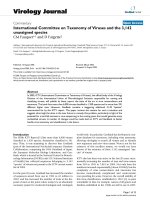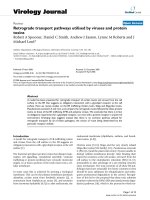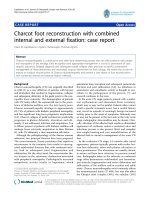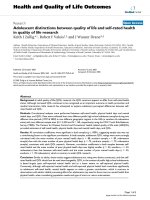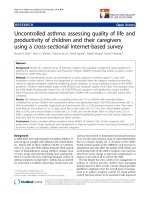báo cáo hóa học:" International Committee on Taxonomy of Viruses and the 3,142 unassigned species" pot
Bạn đang xem bản rút gọn của tài liệu. Xem và tải ngay bản đầy đủ của tài liệu tại đây (927.26 KB, 10 trang )
BioMed Central
Page 1 of 10
(page number not for citation purposes)
Virology Journal
Open Access
Commentary
International Committee on Taxonomy of Viruses and the 3,142
unassigned species
CM Fauquet*
1
and D Fargette
2
Address:
1
International Laboratory for Tropical Agricultural Biotechnology, Danforth Plant Science Center, 975 N. Warson Rd., St. Louis, MO
63132 USA and
2
Institut de Recherche pour le Developpement, BP 64501, 34394 Montpellier cedex 5, France
Email: CM Fauquet* - ; D Fargette -
* Corresponding author
Abstract
In 2005, ICTV (International Committee on Taxonomy of Viruses), the official body of the Virology
Division of the International Union of Microbiological Societies responsible for naming and
classifying viruses, will publish its latest report, the state of the art in virus nomenclature and
taxonomy. The book lists more than 6,000 viruses classified in 1,950 species and in more than 391
different higher taxa. However, GenBank contains a staggering additional 3,142 "species"
unaccounted for by the ICTV report. This paper reviews the reasons for such a situation and
suggests what might be done in the near future to remedy this problem, particularly in light of the
potential for a ten-fold increase in virus sequencing in the coming years that would generate many
unclassified viruses. A number of changes could be made both at ICTV and GenBank to better
handle virus taxonomy and classification in the future.
Introduction
The VIIIth ICTV Report [1] lists more than 6,000 viruses
classified in 1,950 species, themselves classified in 391
taxa. Thus, it was surprising to discover that GenBank
(part of the International Nucleotide Sequence Database
Collaboration, comprising the DNA DataBank of Japan,
the European Molecular Biology Laboratory, and Gen-
Bank, which is located at the National Center for Biotech-
nology Information (NCBI) in the U.S. National Institutes
of Health) has collected sequences belonging to 3,142
"species" of viruses not present in the ICTV current master
list of 2005.
For the past 20 years, GenBank has increased the number
of sequences stored from one in 1982 to 42 million in
2002, and has increased the number of tools at the dis-
posal of users to the point where today it is an absolutely
necessary system for molecular biologists and virologists
world-wide. In particular, GenBank has developed a com-
plete database for taxonomy, including virus taxonomy,
allowing virologists to search all viruses and to identify
new sequences and new virus names. Were it not for the
existence of this excellent system, we would not have
known of the existence of these 3,142 unassigned "spe-
cies" of viruses.
ICTV also has been very active in the last 20 years, incre-
mentally increasing the number of taxa and virus names
from 369 in 1985 to 7,881 in 2004. Not only have the
numbers increased exponentially (about 20-fold), but the
complexity of virus nomenclature and taxonomy has
become tremendously complicated and controversial,
even puzzling for some. However, the overall stability of
this virus classification, established in 1962 [2], is quite
remarkable in that, for example, names of all genera and
families established in the 1980s are still in use in 2005.
Published: 16 August 2005
Virology Journal 2005, 2:64 doi:10.1186/1743-422X-2-64
Received: 08 July 2005
Accepted: 16 August 2005
This article is available from: />© 2005 Fauquet and Fargette; licensee BioMed Central Ltd.
This is an Open Access article distributed under the terms of the Creative Commons Attribution License ( />),
which permits unrestricted use, distribution, and reproduction in any medium, provided the original work is properly cited.
Virology Journal 2005, 2:64 />Page 2 of 10
(page number not for citation purposes)
The advancement with the most impact was the definition
of a virus species [3], which still is not fully understood by
most virologists. Therefore, it is not surprising that its
application in terms of names and concept causes prob-
lems such as the one discussed in this paper.
The listing by GenBank, but not by ICTV, of 3,142 unas-
signed "species" clearly demonstrates a general problem
of the application of the definition of virus species and
that ICTV and GenBank must work in concert to cope with
the day-to-day reality of virology and virus classification,
and that collectively we need to improve the system in
such a way that we will rapidly classify so-called "species"
of viruses and change the current system, so that we do
not find ourselves in a similar situation in the future.
This paper will review the probable causes of the present
situation and will identify actions that could remedy the
situation both at GenBank and at ICTV. Finally a brief
description of the Taxonomic Proposals Management Sys-
tem (TPMS), a new database to electronically handle all
taxonomic proposals for ICTV, will be provided.
Discussion
What are the causes of such a situation?
Review of the species concept
A virus species, as with all other taxonomic levels, is a con-
cept devised by humans to describe concrete (real) biolog-
ical viral entities. The definition of a virus "species",
established [4] and accepted by ICTV [3,5], is as follows:
"A virus species is a polythetic class of viruses that consti-
tutes a replicating lineage and occupies a particular eco-
logical niche". This definition is broad enough to allow
considerable flexibility. It is the responsibility of the virol-
ogists interested in each virus family to apply this defini-
tion to their favorite viruses and to decide how many and
which species should comprise a particular genus of a par-
ticular family [6]. Typically, this is the work of ICTV study-
groups, whose members are experts in particular virus
families [7]. Virus sequences are physical realities that are
not species but entities assigned to a particular species [8].
For example, the 24 bluetongue viruses are assigned to the
species Bluetongue virus in the genus Orbivirus, family Reo-
viridae; thus, 24 viruses assigned to a single species. There-
fore sequences entered in GenBank must be associated
with the name of a virus isolate. The term virus isolate has
no specific definition and can be applied to any virus, so
long as that virus has existed for some time. Several terms
are used by virologists to define a virus entity below the
species level and are somewhat variable and confusing,
but for virus sequences the term "virus isolate" seems the
most appropriate, practical and useful [9].
Sequence and information collection
The intent of GenBank is to collect sequences but the
author, the person who enters the sequences in the data-
base, is responsible for the accuracy of the sequences as
well as for the validity of the associated information about
the sequences, which includes the taxonomic information
about the virus in question. The primary taxonomic infor-
mation pertains to an isolate of a previously recognized
virus or of a newly recognized virus. Consequently, if the
author errs in naming the virus or in its classification, the
entry will be incorrect and might remain incorrect for a
long period of time. GenBank has personnel qualified to
review all entries and they effectively and immediately
correct a large number of obvious mistakes. However,
with regard to "new species", GenBank personnel do not
have the means to determine whether this new taxon is
justified and acceptable or not. Obviously, this policy of
GenBank cannot be changed from without, but it is cer-
tainly possible for GenBank to slightly modify the Entrez
form in order to build in safety nets to avoid such situa-
tions in the future.
GenBank Entrez form and software
The Entrez form of GenBank is a general form for all
organisms, and one of the first questions asks the name of
the organism. Whereas viruses are not organisms, this
question immediately causes ambiguity because it is not
clear whether the isolate name or the name of the species
to which it belongs should be indicated, notwithstanding
the fact that many investigators have not yet understood
the difference between an isolate name, corresponding to
a specific sequence of a virus, and the conceptual species
name, to which a particular isolate has been assigned
[10,8] (see above). The second drawback comes from the
fact that the software dealing with Entrez and connected
to the Taxonomy database of GenBank will by default
assign any new virus name in the field "Organism" to a
new "species" if it does not exist in the ICTV Master list,
from which the current valid classification is derived. This
implies that most of the 3,142 "species" are in fact virus
isolates only (concrete entities), rather than species (con-
ceptual). The third problem arises from the fact that many
virus species names and virus names are identical in the
words that compose them, except that species names are
written in italics and are not abbreviated, while virus
names are not italicized and may be abbreviated [10-13];
unfortunately, databases can only use ASCII characters
and cannot accept italics. It is particularly unfortunate that
we are in this situation and that different names have not
been created for virus species, but this is a reality that can-
not be changed, at least in the short term, and conse-
quently we need to find a way to finesse these problems
and still adhere to acceptable virus nomenclature. It seems
that the only possibility is to redesign software to show
taxonomy as it should be shown, and to restore the
Virology Journal 2005, 2:64 />Page 3 of 10
(page number not for citation purposes)
difference between the two names, if not by italics at least
by some equivalent means. The fourth problem also is
associated with the ASCII code and that is the impossibil-
ity of using Greek letters, which are incorporated in many
phage names. For this, one solution might be to have
ICTV change these names slightly by spelling out the
Greek letters, c.f., "Enterobacteria phage lambda", instead
of "Enterobacteria phage λ".
Exponential increase in sequencing
Because of lower costs and more efficient technology,
sequencing is increasing exponentially. Known viral
sequences already are in the hundreds of thousands and it
is conceivable that millions more will become available in
the coming years. The number of virus taxa and isolates
also increases exponentially and is therefore linearly
related to sequencing activities, as shown in Figure 1. It is
therefore critical to have all data stored and named prop-
erly and with taxonomic updates in real time.
Taxonomic knowledge and consciousness of virologists
Not all virologists determining sequences are fully aware
of or interested in virus taxonomy. These people are the
primary source of information and they consequently are
the primary sources of data entry errors. Left adrift, they
will not make efforts to solve these particular sorts of
problems, so other solutions should be put in place to
remedy the problem. Insisting that they follow taxonomic
rules seems incompatible with the general "author" prin-
ciple of GenBank, but it is possible to "invite" them to
enter the proper information directly on the Entrez form.
Linear correlation between the number of virus sequences recorded at GenBank between 1996 and 2005 and the number of virus taxa and virus isolatesFigure 1
Linear correlation between the number of virus sequences recorded at GenBank between 1996 and 2005 and the number of
virus taxa and virus isolates.
R
2
= 0.9944
0
2,000
4,000
6,000
8,000
10,000
12,000
14,000
16,000
0 50,000 100,000 150,000 200,000 250,000 300,000 350,000 400,000
Number of Virus Sequences in GenBank
Number of Virus Taxa in GenBank
Virology Journal 2005, 2:64 />Page 4 of 10
(page number not for citation purposes)
ICTV organization
The organization structure of ICTV, the generally accepted
leader in viral taxonomy, can be conceived of as pyrami-
dal [7]. The base of the pyramid comprises more than 500
virologists in six Subcommittees, divided into 82 specialty
study-groups (SG), each representing a family of viruses
or an unassigned genus (ICTVnet: forth
center.org/iltab/ictvnet) (Fig. 2).
Each SG comprises from three to 15 experts selected for
their expertise in recognized and new viruses and new
sequences of viruses in each family; obviously this is an
increasingly difficult task, given the rapid increase in avail-
able data. These 82 SGs present taxonomic proposals
from the level of species to the level of order, the propos-
als are reviewed by the Executive Committee (EC) of the
ICTV and, 18 months later, through a posting on ICTVnet
and two rounds of discussions, are then ratified (or not)
and voted upon (or not) by the ICTV membership at large.
This system, although well organized and in full compli-
ance with the international code for virus taxonomy and
nomenclature [14], is neither adapted to a large number
of new isolates and species nor to a quick acceptance, so
that changes are envisioned. In addition, by statute, the
ICTV does not have the mandate to deal with virus iso-
lates, which are not taxa. This is a fundamental problem
because no organization is responsible for certifying iso-
late names or for determining to which virus species they
belong. However, ICTV, for historical reasons, lists a large
number of unclassified virus isolates and SG members are
the most knowledgeable people to deal with such an
issue. Obviously, this should be considered by ICTV in
order to solve this issue of unassigned viruses erroneously
purported to be "species" and found in various databases.
What are the solutions?
It is not the responsibility of the authors to decide
whether their new virus isolates belong to an existing or a
new species, not the responsibility of GenBank to police
authors and organize virus taxonomy and nomenclature,
and not the responsibility of ICTV to deal with non-taxo-
nomic issues, such as isolate names, but it is our commu-
nal responsibility to work together to make the system
functional; and it certainly is feasible. Here we call for col-
laboration of all parties to establish a generally satisfac-
tory system for virus taxonomy and nomenclature of virus
isolates, sequence data, and all other virological data.
Obtaining solutions will necessitate the collaboration of
all those involved in producing, collecting and classifying
viruses.
Classifying the 3,142 unassigned virus names in GenBank
Placing the 3,142 unassigned "species" (which likely are
simply "viruses") registered at GenBank will require man-
ual classification by the ICTV SG members. Most of these
"species" are probably isolates of recognized species and
are in the GenBank database by default as new "species"
because, whether they have been named or not, they have
not been entered in the GenBank forms. Some of these
GenBank "species", however, may actually be new species
that have not yet been submitted to ICTV and, if so, they
should be proposed through the normal channels of the
Taxonomic Proposals (TaxoProps) for evaluation and
official ratification before they can be recognized as new
species.
Improving the management of taxonomic proposals
As a remedy to the general problem of virus classification,
we suggest a two-tier plan. Firstly, GenBank would work
with ICTV to provide to the authors rolling menus, or
automatic writing, offering a list of all the official ICTV
names to select from. This would help avoid spelling
errors or the creation of incorrect new names by authors.
In the case of an unaccepted (or provisional) virus name,
the default should be "unassigned virus in the genus, or in
the family, or in the order or in the virus kingdom". This
assignation to an "unassigned category" would trigger an
email to the relevant ICTV SG chair and to some EC mem-
bers so that ICTV will be immediately aware of this new
entry. This information also would be stored in a pro-
posed new database called TaxoProp Management System
(TPMS), with a pending status to be resolved promptly
(see below). The second tier of the remedy would be to
establish the TPMS database to handle all new TaxoProps
containing information originating from an SG member,
from any individual virologist or directly from GenBank.
Changing ICTV to work in real time
Resolving the mechanics of the system is only a partial
solution and more details are needed in order for this to
be functional in real time. ICTV has established a sophis-
ticated and democratic system to receive, review, discuss,
re-discuss and finally approve taxonomic proposals,
whether they concern a new species or a new order [15].
This system is very sophisticated in principle but is too
complex and takes too long to be compatible with mod-
ern virology work. There are, however, fundamental and
practical differences between a TaxoProp for a new species
and a TaxoProp for everything else, and that is that species
are solely determined by specialty groups (ICTV SGs) and
rarely by the public or the ICTV EC members. The only
envisioned ICTV concern would be to make certain that
the virus species name follows the ICTV International
Rules [14]. It would therefore be possible to computerize
the verification of the names in order to "bypass" ICTV EC
scrutiny and only then obtain approval of the ICTV mem-
bership by electronic voting. This in turn would consider-
ably reduce the turn-around time: essentially, as soon as a
name would be proposed by an ICTV SG, it would be
Virology Journal 2005, 2:64 />Page 5 of 10
(page number not for citation purposes)
automatically verified and accepted if all the rules were
followed.
Increasing relationships between ICTV and GenBank
In order to have taxonomic consistency, it is absolutely
essential that we strengthen the relationships between
ICTV and GenBank. This could be done with an electronic
link between TPMS and GenBank, supplemented with
improved and regular personal relations. For example,
GenBank has appointed virus experts for a number of
families of viruses. It would be more efficient to have Gen-
Bank somehow linked directly to the SG chairs of ICTV, so
that GenBank would get taxonomic experts for advice in
virus taxonomy. This, in turn, would provide a more
active role for the SG members and would activate the
overall system of virus taxonomy.
The TPMS database?
Due to the rapid increase in the number of TaxoProps and
the increasing difficulty in manually handling several
thousand taxonomic names, it is planned by ICTV to cre-
ate a database to handle all ICTV taxa, from inception to
acceptance, and from species to order (Fig. 3).
Overall description of the TPMS
The goal of the TPMS database is to electronically handle
all the virus taxa at large (including virus isolates), i.e.,
those that have been inherited from previous reports,
Diagrammatic organization of the ICTVFigure 2
Diagrammatic organization of the ICTV.
Virus Data SC
ICTV Executive Committee
President
Vice-President
2 Secretaries
6 Subcommittee Chairpersons
8 Elected Members
Life Members
National
Representatives
10 Study-Groups
Barnaviridae
Hypoviridae
Metaviridae
Narnaviridae
Nudoviridae
Partitiviridae
Phycodnaviridae
Protozoal viruses
Pseudoviridae
Totiviridae
Fungal SC
10 Study-Groups
Invertebrate SC
Ascoviridae
Baculoviridae
Dicistroviridae
Iridoviridae
Nimaviridae
Nodaviridae
Polydnaviridae
Roniviridae
Tetraviridae
Unassigned viruses
27 Study-Groups
Adenoviridae
Arenaviridae
Arterivirus
Asfarviridae
Astroviridae
Birnaviridae
Bornavirus
Bunyaviridae
Caliciviridae
Circoviridae
Coronaviridae
Filoviridae
Flaviviridae
Hepadnaviridae
Herpesviridae
Hepeviruses
Orthomyxoviridae
Papillomaviridae
Papovaviridae
Paramyxoviridae
Parvoviridae
Picornaviridae
Polyomaviridae
Poxviridae
Prions
Reoviridae
Retroviridae
Rhabdoviridae
Togaviridae
Unassigned viruses
Vertebrate SC
Plant SC
20 Study-Groups
Bromoviridae
Caulimoviridae
Closterovirus
Comoviridae
Flexiviridae
Furovirus
Geminiviridae
Luteoviridae
Ophiovirus
Potyviridae
Nanoviridae
Sequiviridae
Sobemovirus
Tenuivirus
Tobamovirus
& Tobravirus
Tombusviridae
Tymoviridae
Umbravirus
Viroids
Unassigned viruses
Bacterial SC
Taxonomic
Expertise
Corticoviridae
Cystoviridae
Fuselloviridae
Guttaviridae
Inoviridae
Leviviridae
Lipothrixiviridae
Microviridae
Myoviridae
Plasmaviridae
Podoviridae
Rudiviridae
Salterprovirus
Siphoviridae
Tectiviridae
International Committee on Taxonomy of Viruses
ICTV Organization
Virology Journal 2005, 2:64 />Page 6 of 10
(page number not for citation purposes)
Diagrammatic organization of the TaxoProp Management System (TPMS) databaseFigure 3
Diagrammatic organization of the TaxoProp Management System (TPMS) database.
Virology Journal 2005, 2:64 />Page 7 of 10
(page number not for citation purposes)
those that have been approved between 1999 and 2005,
those in the process of being approved and those that will
be approved in the future.
At any time it will then be possible to:
1- certify the approval status of any TaxoProp
2- elaborate a complete list of approved taxa
3- establish an electronic link with GenBank and all other
virus databases
Structure of the TPMS database
The database will be accessible on line to all ICTV mem-
bers and to the public at large. The database will comprise
a collection of individual files, each one corresponding to
a single taxon (order, family, subfamily, genus, and spe-
cies), and in addition will record isolates. Each TaxoProp
will progress from the initial proposal to the approval of
the taxon by the ICTV. The bulk of the database will be
constituted by all the approved taxa and individual
viruses and should be exportable to other databases for
future use.
Approval process of the TaxoProps
The TaxoProp approval system of ICTV is depicted in Fig-
ure 4. When a TaxoProp form is filed on line, it is then
considered by ICTV and becomes "Considered". A Taxo-
Prop will consist of the proposal itself, of arguments pro-
vided to support the TaxoProp, and by attached
documents to be downloaded by the reader. A unique
TaxoProp number will be automatically generated when a
form is completed or when a TaxoProp is modified by the
author. After consideration, it becomes "Considered", and
comments of the ICTV are added on line and available to
the public at large. Comments can be added by any virol-
ogist and the author of the TaxoProp can respond on line.
The change of level will be done through a voting system
in which ICTV EC members can view the votes at any time
and will be operated by the TPMS curator. When accepted
by ICTV, the TaxoProp becomes "Accepted" and com-
ments are no longer added. When the ICTV at large has
voted to approve the TaxoProp, it becomes "Voted" and is
de facto a ratified taxon of the ICTV.
Filing TaxoProps
TaxoProps can be filed by any virologist, but it is likely
that most will be filed by SG members. There will be a set
of TaxoProps to choose from on line according to the sort
of taxon proposed: an isolate (although not a formal
taxon), a species, a type species, a genus, a subfamily, a
family, an order, or any other taxon proposed by any
virologist. Higher taxa cannot be proposed unless a lower
level has been proposed and accepted. A genus must have
a type species and at least one species or a list of species in
the genus. Any proposed new taxa must have a name fol-
lowing the ICTV Code [14].
Link with species demarcation criteria lists
For each genus, it will be possible to list the species demar-
cation criteria of that genus for the benefit of the author
and readers of the species TaxoProps. These lists will be
extracted from the VIIIth Report and from subsequent
updates. It is envisioned that these lists of species demar-
cation criteria will become useful tools for ICTV to search
for a better means of making the overall virus taxonomy
more uniform in the future.
Special case of TaxoProp isolates
Although isolates do not comprise formal taxa, recording
and listing them are indispensable for the creation of spe-
cies taxa and also for practical purposes. Virus species
being defined from properties of virus isolates, ICTV
records the existence of isolates in order to define species.
There are no formal rules for naming isolates and, conse-
quently, any name could potentially be accepted. How-
ever, it is common sense that these names follow
previously established names and follow somewhat virus
species names rules to avoid complete chaos [14,9].
Accepting TaxoProp species
TaxoProp species, after being proposed by the SGs, will
automatically be reviewed to ensure that they follow the
ICTV International Code and, if they do, will automati-
cally be approved electronically. However, a vote by the
ICTV membership at large will still be necessary for it to
be considered as ratified by the ICTV; this also could be
done electronically.
Approved taxa
All approved taxa, because they have been inherited, will
be entered in the TPMS, so that the database will be
updated automatically and in real time and can be linked
to GenBank, ICTVdb (ICTV database) and other data-
bases. Files for each taxon will archive all the comments
and votes so that we can always return to this information
if needed. However, public access to the TPMS for the
ratified ICTV Master List will remain under control of the
President of ICTV.
Generating the ratified list of taxa
Using TPMS, it will be possible to generate a complete list
of approved taxa at any time, and this will be possible
either alphabetically or taxonomically. Accepted taxa also
will be presented according to the order of presentation of
virus taxonomy: dsDNA, ssDNA, rtDNA, rtRNA, dsRNA,
ssNRNA, ssPRNA, SAT (Satellites), VIR (Viroids), UN
(unassigned). Within each category, the families will be
classified according to the Order of Presentation of the
Virology Journal 2005, 2:64 />Page 8 of 10
(page number not for citation purposes)
Diagrammatic organization of the taxonomic proposals system at ICTVFigure 4
Diagrammatic organization of the taxonomic proposals system at ICTV.
1- Taxonomic Proposals are generated by
ICTV Study-Groups and posted on:
ICTV Members can comment
2- Taxonomic Proposals are Reviewed by
the ICTV Executive Committee and
remarks are posted on:
Everybody can comment these
proposals
3- Taxonomic Proposals Revised by the
Study-Groups are reviewed a second
time by the ICTV Executive Committee:
- if not acceptable, results with com-
ments are posted on:
Everybody can comment these
proposals
- if acceptable results are posted on:
4- Taxonomic Proposals accepted by the
ICTV Executive Committee are voted by
ICTV Members by postal vote and pub-
lished on:
ICTVnet
www.danforthcenter.org/iltab/ICTVnet
New Procedure to Review Taxonomic Proposals
Review Stage
(Reviewed Taxo prop on ICTVnet)
Comment by
virologists at large
Reviewed
Taxonomic Proposals
EC Meeting 2
Discussion and Comments by
Executive Committee
Discussion and Comments by
Executive Committee
EC Meeting 1
Consideration Stage
(Considered Taxo prop on ICTVnet)
Comment by
ICTV mem-
bers
Considered Taxonomic Proposal
Code 01
Acceptance Stage
(Accepted Taxo prop on ICTVnet)
Final voting by full ICTV
ICTV Secretary Checking
and Coding
New Taxa
Accepted
Taxonomic Proposals
Considered
Taxonomic Proposals
Proposer
e.g. Study Group
ICTV TaxoProps New Procedure
ICTVnet
ICTVnet
ICTVnet
ICTV WebSite
Virology Division News
ICTV Reports
Virology Journal 2005, 2:64 />Page 9 of 10
(page number not for citation purposes)
Virus. Taxonomy Species will be assigned to a genus and
classified alphabetically within the genus. The species taxa
should comprise at least one isolate but include as many
as described.
Searching the TPMS database
Any virologist will have access to the TPMS database on
line anytime so that he or she can verify names, either
with an alphabetical pull down menu system or by use of
a search engine.
Linking the TPMS database to other databases
TPMS will de facto become the definitive reference for
virus taxonomy and nomenclature. Once approved by the
ICTV President, typically after each ICTV EC meeting or
after a certain period of time (such as six months), the
TPMS database will be electronically linked with Gen-
Bank, ICTVdb, and other associated databases to ensure
complete homogeneity of the virus taxonomy and
nomenclature. This tool will be particularly important for
the members of the International Virus Database Net-
work, who recognize the critical need for such a system,
and to homogenize and update in real time the virus tax-
onomy and nomenclature.
Conclusion
Because sequencing is much less expensive and increas-
ingly done these days, it is assumed that investigators will
generate many more sequences of known and unknown
viruses in the very near future. The number of sequences
is increasing exponentially and so will the number of virus
names and virus taxa, as they are directly correlated with
sequencing activities. It is clear that past management of
virus taxonomy will become inadequate commensurate
with this increase and that more rapid and better-adapted
management is required. The electronic connection
between databases storing sequences, storing biological
data or handling taxonomic proposals is the only solution
for the future. Human intervention is indispensable, but
should be restricted to the decision-making process; all
other interventions might best be done electronically.
This will mean better collaboration between the people
responsible for the different types of databases, the people
involved in the ICTV organization, and individual investi-
gators themselves. Software will have to be adapted or
devised to better fit virus taxonomy and nomenclature,
ICTV will have to better appreciate day-to-day realities
such as dealing with virus isolates, and scientists will have
to be better educated in virus taxonomy. Regarding the
decision-making process for virus species and isolates, a
much greater role for the ICTV SGs will be necessary
because the ultimate expertise resides with them in deter-
mining which new viruses fit into existing taxa and which
must be placed in defined new taxa. Consequently, it
would be best for ICTV to work more closely with Gen-
Bank to establish the electronic TPMS database to work in
real time and to cope with an acutely burgeoning number
of taxa.
Competing interests
The author(s) declare that they have no competing
interests.
Authors' contributions
The authors contributed equally to the writing of this
paper.
Acknowledgements
The opinions expressed in this paper reflect the personal opinions of the
authors and should not be misconstrued as an official position of the ICTV
or GenBank. A Taxonomic Proposal (TaxoProps) Management System
(TPMS) database has been devised by the authors and will be officially pro-
posed to ICTV. Its complete description will appear in Virology Division
News, Archives of Virology.
We thank Dr. F. Nino de Medias-France for his contribution to the elabo-
ration of structure of the TPMS database, and Dr. Andy Ball for his review
of the manuscript and his useful suggestions. Dr. Charlie Calisher is warmly
acknowledged for all the time he took to edit this paper and make com-
ments well taken by the authors.
References
1. Virus Taxonomy, VIIIth Report of the ICTV Edited by: Fauquet CM, Mayo
MA, Maniloff J, Desselberger U, Ball LA. London: Elsevier/Academic
Press; 2005.
2. Lwoff A, Horne R, Tournier P: A system of viruses. Cold Spring
Harbor Symp Quant Biol 1962, 7:51-55.
3. van Regenmortel MHV, Maniloff J, Calisher C: The concept of virus
species. Arch Virol 1991, 120:313-314.
4. van Regenmortel MHV: Virus species, a much overlooked but
essential concept in virus classification. Intervirology 1990,
31:241-254.
5. van Regenmortel MHV: Introduction to the species concept in
virus taxonomy. In Virus Taxonomy. Seventh Report of the Interna-
tional Committee on Taxonomy of Viruses Edited by: van Regenmortel
MHV, Fauquet C., Bishop DHL, Carstens EB, Estes MK, Lemon SM,
McGeogh DJ, Maniloff J, Mayo MA, Pringle CR, Wickner RB. San
Diego: Academic Press; 2000:3-16.
6. van Regenmortel MHV, Bishop DHL, Fauquet CM, Maniloff J, Mayo
MA: Guidelines to the demarcation of virus species. Arch Virol
1997, 142:1505-1518.
7. Mayo MA, Fauquet CM: The current composition of ICTV. Arch
Virol 2000, 145:1497-1504.
8. van Regenmortel MHV: Viruses are real, virus species are man-
made, taxonomic constructions. Arch Virol 2003,
148:2483-2490.
9. Fauquet CM, Stanley J: Revising the way we conceive and name
viruses below the species level. A review of geminivirus tax-
onomy calls for new standardized isolate descriptors. Arch
Virol in press.
10. Drebot MA, Henchal E, Hjelle B, LeDuc JW, Repik PM, Roehrig JT,
Schmaljohn CS, Shope RE, Tesh RB, Weaver SC, Calisher CH:
Improved clarity of meaning from the use of both formal
species names and common (vernacular) virus names in
virological literature. Arch Virol 2002, 147:2465-2472.
11. van Regenmortel MHV: How to write the names of virus
species. Arch Virol 1999, 144:1041-1042.
12. van Regenmortel MHV: On the relative merits of italics, Latin
and binomial nomenclature in virus taxonomy. Arch Virol 2000,
145:433-441.
13. Calisher CH, Mahy BWJ: Taxonomy: get it right or leave it
alone (editorial). Am J Trop Med Hyg 2003, 68:505-506.
Publish with BioMed Central and every
scientist can read your work free of charge
"BioMed Central will be the most significant development for
disseminating the results of biomedical research in our lifetime."
Sir Paul Nurse, Cancer Research UK
Your research papers will be:
available free of charge to the entire biomedical community
peer reviewed and published immediately upon acceptance
cited in PubMed and archived on PubMed Central
yours — you keep the copyright
Submit your manuscript here:
/>BioMedcentral
Virology Journal 2005, 2:64 />Page 10 of 10
(page number not for citation purposes)
14. Mayo MA, Horzinek M: A revised version of the International
Code of Virus Classification and Nomenclature. Arch Virol
1998, 143:1645-1654.
15. Mayo MA, Fauquet CM, Maniloff J: Taxonomic proposals on the
Web: new ICTV consultative procedures. Arch Virol 2003,
148:609-611.

